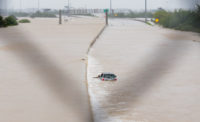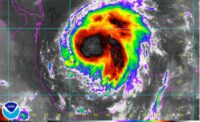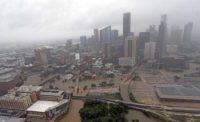Businesses, contractors and government agencies in South Texas began on Aug. 28 to assess damage left by Hurricane Harvey. Officials also took steps to prevent further damage as flood waters continue to rise, including releases from flood-control dams.
A number of cities south of Interstate-10 have issued mandatory evacuations, including Missouri City, Sugar Land, Rosenberg and Bay City near the Brazos River, as that waterway is expected to reach 59 ft on Aug. 29—equivalent to an 800-yr flood.
A number of cities south of Interstate-10 have issued mandatory evacuation orders, including Missouri City, Sugar Land, Rosenberg and Bay City near the Brazos River. That waterway is expected to reach 59 ft on Aug. 29—equivalent to an 800-yr flood.
The assessments were made more difficult because almost all transportation networks remained completely shut down on Aug. 28. All flights were suspended in the Houston Airport System, all port operations ceased at the ports of Houston and Galveston, and the Texas Dept. of Transportation reports that more than 200 highway locations are closed or flooded.
"Clearly, the situation in Houston is dire," says David Singleton, president and CEO of locally-based subcontractor Griffin Dewatering. "We are unable to get to many of the sites where we have active dewatering occurring. Many projects have been impacted. The city is literally impassable at this point."
Although Hurricane Harvey was reclassified as a tropical storm during the day, the National Weather Service predicted that more rain would fall and that new areas of the state could flood.
"I think that the final magnitude of the storm has not yet been defined and the enormity of it will be incredible," adds Bob Pence, chairman of Fort Worth-based infrastructure engineer Freese and Nichols, whose two offices in Houston and Corpus Christi are not set to open until at least Aug. 30.
The Federal Railroad Administration declared a state of emergency that ceased operations on Houston metro, Amtrak and Class 1 freight railroads.
“Across our projects and Houston office, we continue to evaluate the current weather conditions and heed the advice of the local authorities before re-opening for normal work activities,” said Bechtel spokesman Mat Ovenen.
Bechtel, which is constructing a liquefied natural gas terminal in Corpus Christi for Cheniere Energy, uncovered only minor cosmetic impacts from the storm that came ashore late on Aug. 25, according to Cheniere. The company did not shut down LNG production at its Sabine Pass facility, west of Houston.
A spokeswoman for Fluor Corp. says that "our project sites in the affected areas are also closed," but she declined to identify specific projects or whether any had sustained flood-related damage.
Texas Energy Sites Went Offline
Several refineries were offline on Aug. 28, including Exxon Mobil’s Baytown refinery on the Houston Ship Channel – the nation’s second largest refinery. In a statement, the company said extreme weather and flooding caused “operational issues” at the refinery, which were not outlined in detail.
Other refineries were unable to operate because the ship channels were closed.
The US Army Corps of Engineers said Aug. 28 it had started releasing around 800 cu ft per second from the Addicks and Barker reservoirs. Throughout the day, the Corps expected to release a total of 4,000 cu ft per second from each reservoir, for a combined total of 8,000 cfs.
In a statement, Col. Lars Zetterstrom, Galveston District commander said: “Both reservoirs are rising more than half a foot per hour. If we don’t begin releasing now, the volume of uncontrolled water around the dams will be higher and have a greater impact on the surrounding communities. We are coordinating floodwater releases from Addicks and Barker with the Harris County Flood Control District so they can make informed decisions for the communities they support.”
Water in the reservoirs will flow into the Buffalo Bayou whether it goes through the gates or around the end of the dams, Zetterstrom said. The Corps reported that it is confident that the structures continue to perform as they were designed to do.
"We have an active job at the Addicks and Barker dam site," says Singleton of Griffin Dewatering. "We took some proactive measures to attempt to protect equipment, but we are currently uncertain as to how the construction site has been impacted."
The San Jacinto River Authority Officials also reported that record levels of water are being released from Lake Conroe Dam. Affected neighborhoods were being evacuated.
According to the announcement, at 72 hours into the storm, the Lake Conroe watershed has received an average of 18 in. of rainfall, which has caused the lake water level to rise over 4.25 ft above normal pool elevation.
The agency reported: “SJRA operations personnel at the Lake Conroe dam have increased the rate of release to 39,600 cubic feet per second. This is a new record release rate for Lake Conroe, surpassing the 1994 storm event, which peaked at a release of 33,300 cfs. A tremendous volume of water is still flowing into the reservoir, and Lake Conroe personnel are working to slow the rise."
Infrastructure Damage: An Unfinished Story
Pence of Freese and Nichols said, "It is early in the total damage that will happen, as the Houston area is expecting another few days of strong rain." He added that the firm's Houston and Corpus Christi offices are closed "until at least Wednesday."
According to Pence, precautions that its municipal clients took included lowering lake and water retainage structure levels to accommodate the rainfall. But the 24 in. of rain that has fallen in Houston "may double depending on how long the storm mass stays in place."
In addition to flood damage, Pence noted that cresting rivers will affect "slope and foundation stability of the road networks" and levee stability. Pence says the firm has been contacted by FEMA for flood assessment work and expects similar assignments from local clients.
AEP Texas, the utility that covers much of the area hit by the storm, reports that as of 11 a.m. CDT on Aug. 28, there were about 150,500 people without power in its territory, down from its peak of 220,000. A total of about 300,000 throughout Texas were without power on Aug. 26.
— Aileen Cho, Louise Poirier, Debra K. Rubin and Pam Radtke Russell





Post a comment to this article
Report Abusive Comment